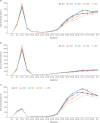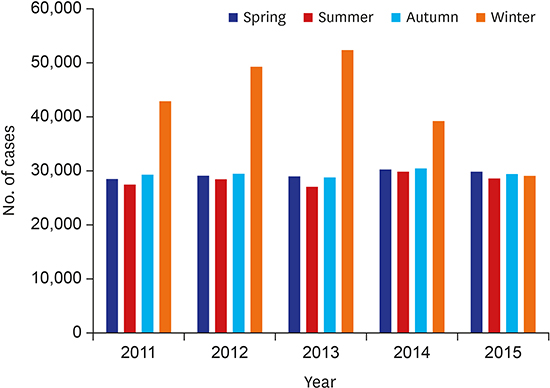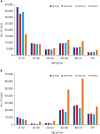1. Court-Brown CM, Caesar B. Epidemiology of adult fractures: a review. Injury. 2006; 37(8):691–697.

2. Rennie L, Court-Brown CM, Mok JY, Beattie TF. The epidemiology of fractures in children. Injury. 2007; 38(8):913–922.

3. Chung KC, Spilson SV. The frequency and epidemiology of hand and forearm fractures in the United States. J Hand Surg Am. 2001; 26(5):908–915.

4. O'Neill TW, Cooper C, Finn JD, Lunt M, Purdie D, Reid DM, et al. Incidence of distal forearm fracture in British men and women. Osteoporos Int. 2001; 12(7):555–558.
5. Shauver MJ, Yin H, Banerjee M, Chung KC. Current and future national costs to medicare for the treatment of distal radius fracture in the elderly. J Hand Surg Am. 2011; 36(8):1282–1287.

6. Diamantopoulos AP, Rohde G, Johnsrud I, Skoie IM, Hochberg M, Haugeberg G. The epidemiology of low- and high-energy distal radius fracture in middle-aged and elderly men and women in Southern Norway. PLoS One. 2012; 7(8):e43367.

7. Flinkkilä T, Sirniö K, Hippi M, Hartonen S, Ruuhela R, Ohtonen P, et al. Epidemiology and seasonal variation of distal radius fractures in Oulu, Finland. Osteoporos Int. 2011; 22(8):2307–2312.

8. Øyen J, Rohde GE, Hochberg M, Johnsen V, Haugeberg G. Low-energy distal radius fractures in middle-aged and elderly women-seasonal variations, prevalence of osteoporosis, and associates with fractures. Osteoporos Int. 2010; 21(7):1247–1255.

9. Bischoff-Ferrari HA, Orav JE, Barrett JA, Baron JA. Effect of seasonality and weather on fracture risk in individuals 65 years and older. Osteoporos Int. 2007; 18(9):1225–1233.
10. Giladi AM, Shauver MJ, Ho A, Zhong L, Kim HM, Chung KC. Variation in the incidence of distal radius fractures in the U.S. elderly as related to slippery weather conditions. Plast Reconstr Surg. 2014; 133(2):321–332.

11. Sebastin SJ, Chung KC. An Asian perspective on the management of distal radius fractures. Hand Clin. 2012; 28(2):151–156.

12. Lee HJ, Han SH, Jo YG, Lee SH, Bong ST. Epidemiology and seasonal variance of incidence of distal radius fractures. J Korean Orthop Assoc. 2015; 50(4):307–312.

13. Jo YH, Lee BG, Kim JH, Lee CH, Kim SJ, Choi WS, et al. National surgical trends for distal radius fractures in Korea. J Korean Med Sci. 2017; 32(7):1181–1186.

14. Kwon GD, Jang S, Lee A, Park CM, Lee YK, Kim TY, et al. Incidence and mortality after distal radius fractures in adults aged 50 years and older in Korea. J Korean Med Sci. 2016; 31(4):630–634.

15. Park C, Ha YC, Jang S, Jang S, Yoon HK, Lee YK. The incidence and residual lifetime risk of osteoporosis-related fractures in Korea. J Bone Miner Metab. 2011; 29(6):744–751.

16. Khosla S, Melton LJ 3rd, Dekutoski MB, Achenbach SJ, Oberg AL, Riggs BL. Incidence of childhood distal forearm fractures over 30 years: a population-based study. JAMA. 2003; 290(11):1479–1485.
17. Parfitt AM. The two faces of growth: benefits and risks to bone integrity. Osteoporos Int. 1994; 4(6):382–398.

18. Caspersen CJ, Pereira MA, Curran KM. Changes in physical activity patterns in the United States, by sex and cross-sectional age. Med Sci Sports Exerc. 2000; 32(9):1601–1609.

19. Ryan LM, Teach SJ, Searcy K, Singer SA, Wood R, Wright JL, et al. Epidemiology of pediatric forearm fractures in Washington, DC. J Trauma. 2010; 69(4):Suppl. S200–S205.

20. Shah NS, Buzas D, Zinberg EM. Epidemiologic dynamics contributing to pediatric wrist fractures in the United States. Hand (NY). 2015; 10(2):266–271.

21. Wareham K, Johansen A, Stone MD, Saunders J, Jones S, Lyons RA. Seasonal variation in the incidence of wrist and forearm fractures, and its consequences. Injury. 2003; 34(3):219–222.

22. Tsai CH, Muo CH, Fong YC, Lo WY, Chen YJ, Hsu HC, et al. A population-based study on trend in incidence of distal radial fractures in adults in Taiwan in 2000–2007. Osteoporos Int. 2011; 22(11):2809–2815.

23. Louer CR, Boone SL, Guthrie AK, Motley JR, Calfee RP, Wall LB. Postural stability in older adults with a distal radial fracture. J Bone Joint Surg Am. 2016; 98(14):1176–1182.

24. Melton LJ 3rd, Christen D, Riggs BL, Achenbach SJ, Müller R, van Lenthe GH, et al. Assessing forearm fracture risk in postmenopausal women. Osteoporos Int. 2010; 21(7):1161–1169.

25. Jang WY, Chung MS, Baek GH, Song CH, Cho HE, Gong HS. Vitamin D levels in post-menopausal Korean women with a distal radius fracture. Injury. 2012; 43(2):237–241.

26. Low Choy NL, Brauer SG, Nitz JC. Age-related changes in strength and somatosensation during midlife: rationale for targeted preventive intervention programs. Ann N Y Acad Sci. 2007; 1114(1):180–193.

27. Fu S, Choy NL, Nitz J. Controlling balance decline across the menopause using a balance-strategy training program: a randomized, controlled trial. Climacteric. 2009; 12(2):165–176.

28. Ryoo SB, Kwon WT, Jhun JG. Characteristics of wintertime daily and extreme minimum temperature over South Korea. Int J Climatol. 2004; 24(2):145–160.

29. Zhang Y, Sperber KR, Boyle JS. Climatology and interannual variation of the East Asian winter monsoon: Results from the 1979–95 NCEP/NCAR reanalysis. Mon Weather Rev. 1997; 125(10):2605–2619.












 PDF
PDF Citation
Citation Print
Print








 XML Download
XML Download